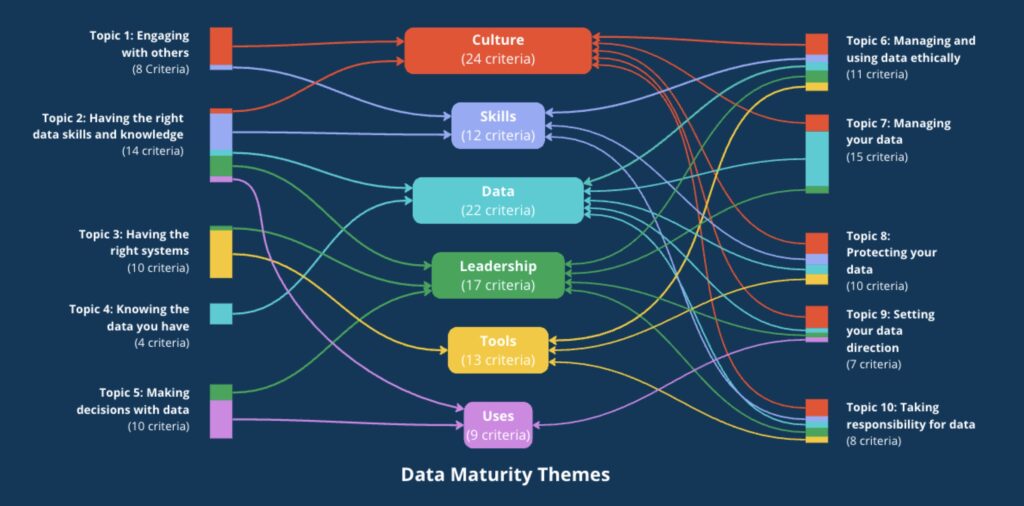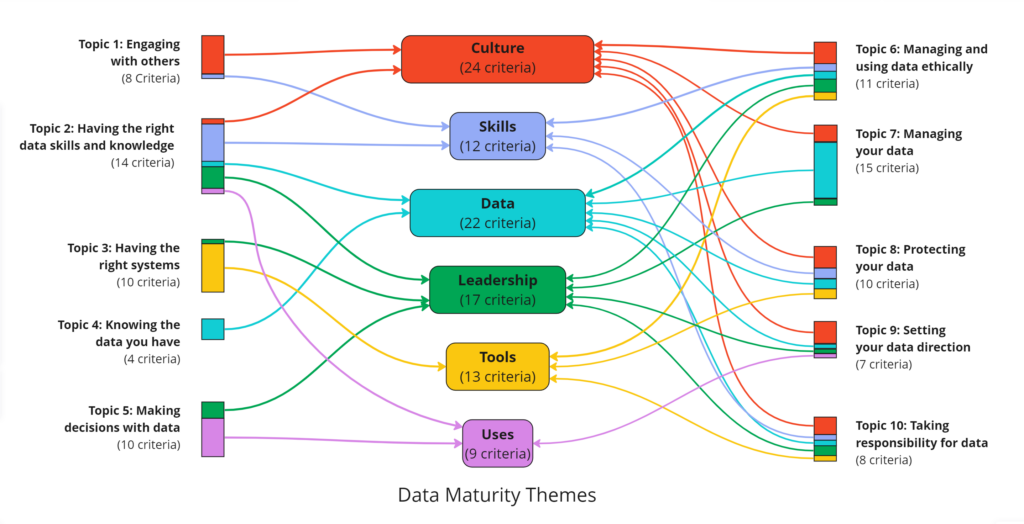
We’ve been looking at the UK Government’s Data Maturity Assessment for Government Framework published in March this year.
We see it as an important framework, in that it will inform central governmental (and possibly other) organisational data strategies in the coming years, especially in the context of the National Data Strategy, so have taken a quick look at it.
Getting to know the framework
The new framework was developed by the Government Data Quality Hub (DQHub) based in the Office for National Statistics (ONS). They chose to adapt Data Orchard’s existing Data Maturity Framework for the not-for-profit sector . The new framework was specifically designed for use in the public sector.
The Data Maturity Assessment (DMA) Framework was then handed over to the Central Digital and Data Office (CDDO), based in the Cabinet Office to take forward and embed across government. The Framework is described as:
… the foundation for measuring, improving and maintaining the health and strength of an organisation’s data ecosystem.
see: Government’s Data Maturity Assessment for Government Framework
It defines data maturity – as the capability, effectiveness and readiness to use data, and notes that data maturity is fundamental to achieving its strategic, operational and corporate priorities.
At first sight the framework seems a bit complex, adding dimensions of ‘Topic’ and ‘Row’ to the ‘Themes’ in the original Data Orchard Data Maturity Framework. The DMA Guidance webpage describes it as follows:
It is a self-assessment framework and is organised around 10 topics, intersected with six themes, arranged across rows, with each row providing 5 maturity levels. An assessment is carried out by gathering evidence and information which is used to determine an organisation’s current maturity level for each row.
see: Government’s Data Maturity Assessment for Government Framework
The Data Maturity Assessment document is organised by Topic (10 topics), e.g., … these each relate to specific ‘data issues and concepts’ that frame each Topic. The example below is for the Topics ‘Engaging with others’ and ‘Having the right data skills and knowledge’.
![screenshot of page from page 4 of the Data Maturity Assessment document. It shows two topics (Engaging with others and ‘Having the right data skills and knowledge’] and their descriptions - including short summary, data issues and concepts and linked Themes. Instance of Engaging with others has Summary: Your engagement with others in the data ecosystem and, ‘Data issues and concepts’ of e.g. Understanding user needs, collaboration, Data sharing and Networks and communities of practice. Finally it has Themes of Culture and Skills](https://www.epimorphics.com/wp-content/uploads/2023/04/DMA-Framework-Document-page-4-screenshot-1024x721.png)
The actual assessment criteria are captured in Rows – each Topic has a number Rows, with each Row representing specific features or behaviours associated with the Topic: This is illustrated in the screenshot below, taken from the Excel spreadsheet tool to help collect and collate results ‘Delivering the Data Maturity Assessment: record and calculate results’.
![Screenshot of Sheet ‘2. Record data maturity levels’ from the Microsoft Excel file DataMaturityAssessment_RecordCalculateResults.xlsx linked to from https://www.gov.uk/government/publications/delivering-a-data-maturity-assessment-objectives-and-resources .
It shows an example of data collection table for a Topic ‘Engaging with others’ and the Row (criteria) labellabe), e.g. 1. Making data available to those who need it, 2. Sharing data with stakeholders and customers, etc. Each row also has a ‘Theme’ column that lists the relevant ‘Theme’ for a Row and a ‘Current data maturity level’ column for input.. Also has a sub table showing the possible values 1-5 for maturity levels]](https://www.epimorphics.com/wp-content/uploads/2023/04/DMA-Framework-Assessment-Tool-screenshot-1024x530.png)
Each Row has a set of Levels that assess the maturity, as measured against a series of Statements representing outcomes of data practice, starting with ‘1 -Beginning’, ‘2 – Emerging’, running through to ‘5 – Mastering’. (see figure above).
Each Row is also associated with a Theme, such as culture, skills, tools, and leadership, that represent cross cutting organisational characteristics with respect to data.
We struggled slightly to understand how Topics and Themes were related. In order to help understand the (essentially matrix) relationship, we produced a visualisation. It took a few iterations to be able to represent some of the features. Our current version is shown below.

The six themes run down the centre and ten topics the sides. The width of the central theme represents the number of Rows associated with the specific Theme in the Assessment Framework (which we call ‘criteria’ in the diagram as Rows seemed unintuitive in a standalone diagram).
The Topics are represented by bars, the heights of the bar heights representing the number of Rows (criteria) in each Topic. The links show which topics have Rows in which Theme. Each colour in the bars being proportional to the number of Rows of each Theme in that Topic.
This helps see the relationships, e.g. Culture maps to the most with 8, Topics, where Uses has least with 3. Some Topics map to 5 Themes where Topic 4 (Knowing the data you have) links only to Data.
We also produced a spreadsheet that shows Topics, Themes and Rows – similarly to the provided spreadsheet tool mentioned above – but also the Level for each Row descriptors so they can be seen at the same time and also added a ‘target level’ column to represent a possible medium term goal for each Row. We did this to help have conversations in workshops around the framework, and to have the common descriptions to hand.

In case this is of use to others you can download the spreadsheet here: (data-maturity-assessment-for-government-Epimorphics-exploration-eg.xlsx – 138kb MS Excel )
Curiosity and next steps
This first exploration of the DMA Framework has been helpful in beginning to understand its structure and how it compares to others we seen and used before, such as the Data Orchard Data Maturity Framework already mentioned and the Open Data Institute’s Open Data Maturity Model. We have been looking at the framework as a helpful way to prioritise some aspects of public sector projects that we are supporting, but also something that has the potential to make a difference. We look forward to joining in the conversation.
In the meantime, we are interested in hearing organisations plans:
- How are you doing your assessments? Will you be doing workshops with lots of stakeholders or something more constrained
- Are you planning to publish your assessments?
